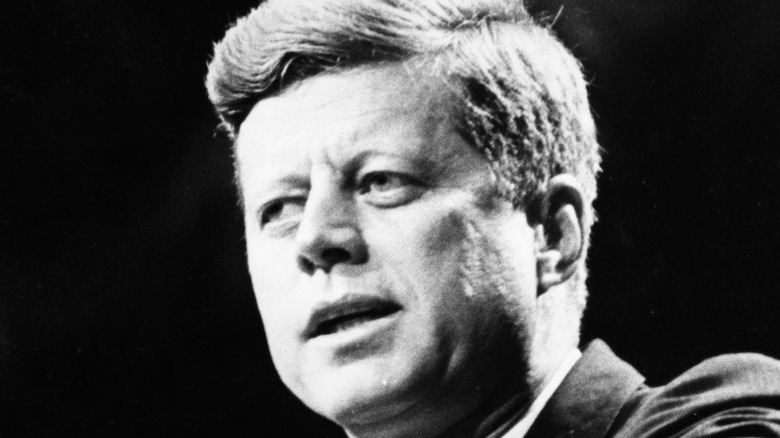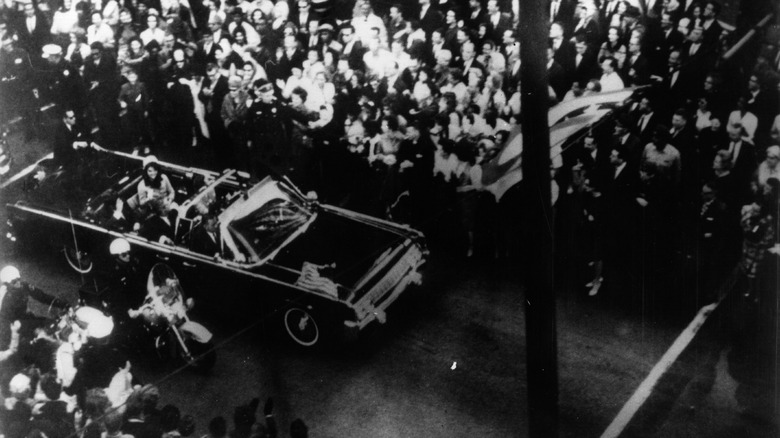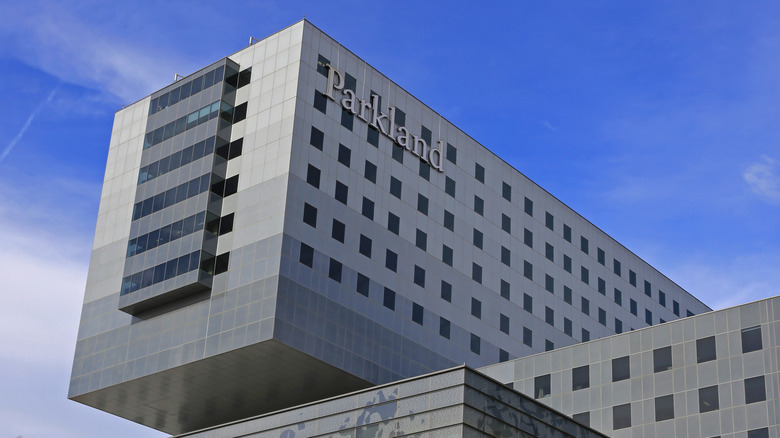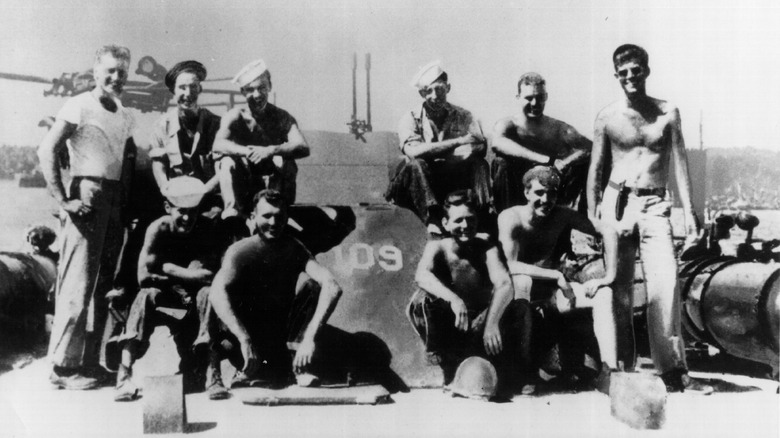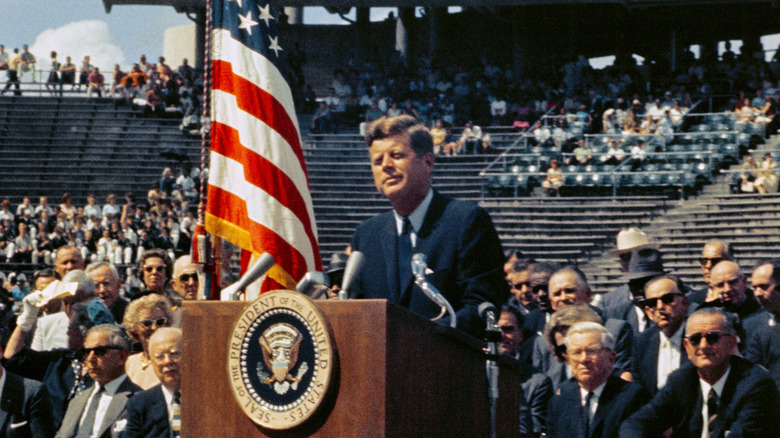Disturbing Details Found In John F. Kennedy's Autopsy Report
After shots rang out in Dallas's Dealey Plaza on November 22, 1963, the entire trajectory of American history changed In a matter of seconds. John F. Kennedy, the charismatic 35th President of the United States, was assassinated at the age of 46.
Just hours after the president's death, an autopsy was performed and its findings were recorded in a report which is publicly available through the United States National Archives. The report outlines the autopsy's findings, including the severity of Kennedy's injuries and what happened in the moments after he arrived at the hospital.
Of course, the Kennedy assassination is surrounded by all kinds of conspiracy theories, leading many to even question the validity of official documents, but the two pathologists who performed the autopsy on the president — Dr. James J. Humes and Dr. J. Thornton Boswell — reaffirmed their findings in 1992, according to The New York Times, nearly 30 years later.
An early account of what occurred
One of the first pieces of information mentioned in the autopsy report is the president's time of death listed as "1300 CST" or 1 p.m. Central Standard Time on November 22, 1963. The autopsy itself was performed just hours later, at "2000 EST," or 8 p.m. Eastern Standard Time. This means the findings contained in the autopsy came extremely early in the investigative process.
The report's "Clinical Summary" offers many of the details that were known about the assassination at the time, including the president being in an open car, and mentions the location of each of the car's occupants: President Kennedy, first lady Jackie Kennedy, Texas Governor John B. Connally, and Texas first lady Nellie Connally. (The Connallys' last name is misspelled "Connolly" in this part of the report). The president and first lady sat in the back seat, with the governor and first lady of Texas in front of them. Both President Kennedy and Governor Connally were seated on the passenger side of the vehicle. All of this will sound familiar to anyone who has ever seen images of the moments leading up to the assassination.
One other interesting piece of information in the "Clinical Summary" is the mention of an eyewitness statement from Dallas Times Herald photographer Bob Jackson, who claimed to have seen a rifle barrel "disappearing" into the upper-story window of the Texas School Book Depository Building after hearing three gunshots ring out through Dealey Plaza.
The attempts to save President Kennedy
According to Britannica, the shots that killed John F. Kennedy were fired at roughly 12:30 p.m. The autopsy report paints a picture of what happened in the half-hour between the president being shot and being declared dead at 1 p.m.
After being wounded, the president was immediately driven to Dallas' Parkland Hospital. There he was tended by Dr. Malcolm Perry. The pathologists performing the autopsy spoke to Dr. Perry by phone and he told them the measures taken to save the president during this time; despite the massive trauma he had suffered, the president was still alive upon arrival at Parkland.
According to the report, Dr. Perry immediately noted the two separate wounds the president had received: a large one to the head and a small one to the neck. He then performed a tracheostomy — a procedure (per Johns Hopkins Medicine) intended to allow access to the breathing tube — on the president, by extending the smaller wound in the president's neck. It was at this point that doctors observed blood bubbling through the wound — an indication of escaping air — and damage to the president's tracheal wall. Incisions were also made in the president's chest to "combat subcutaneous emphysema."
Kennedy received intravenous blood and saline transfusions, as well as oxygen. Despite the efforts, the president went into cardiac arrest. Attempts to save him after that failed, and he was pronounced dead.
Autopsy shows indications of Kennedy's back trouble
John F. Kennedy was the youngest president to ever take office when he was sworn in at the age of 43. He was known as a healthy middle-aged man, and the autopsy report reflects this idea for the most part. It does, however, mention several scars on the president's body.
One was on his right thigh, and another was an eight centimeter "McBurney abdominal incision," which was from an appendectomy. The final one was located on the president's back, "over the lumbar spine in the midline," according to the report. This one was larger measuring 15 centimeters. Kennedy was known to suffer from chronic back pain, but according to the Journal of Neurosurgery, the origins of where it came from are unclear. Kennedy himself cited a football injury he sustained while attending Harvard in 1937.
This back injury would prevent him from enlisting in the Army. It would take string pulling on the part of his father, Joseph P. Kennedy who was the U.S. Ambassador to Great Britain, to get him into the Navy Reserves. (He's pictured above, standing far right, with his crew on PT 109.)
Kennedy's back pain was made worse during his time in World War II, and it lead to his first of three back surgeries, one of which was responsible for the large scar. Despite these surgeries, the back pain would continue to plague the president for his entire life.
They saved the president's brain and the report's verdict
In the autopsy report, it's mentioned that President Kennedy's brain was removed for further evaluation, and the details of that evaluation are included toward the end of the report. It weighed around 1500 grams (3.3 pounds). The pathologists observed that the right hemisphere of the president's brain was severely damaged by the shooting.
The president's injuries caused a laceration of his corpus callosum. According to Medical News Today, the corpus callosum is the part of the brain that allows information to transfer from one side of the brain to the other. Surgically cutting the corpus callosum is a method sometimes used to help patients suffering from seizures.
The report asserts that the president's death was due to "two perforating gunshot wounds inflicted by high-velocity projectiles fired by a person or persons unknown." It also mentions that the projectiles were fired from a point "behind and somewhat above the level of the deceased."
Pictures were taken during the autopsy, and though they've since been released, it mentions that the images were exposed, but not developed, and given to Secret Service Agent Roy H. Kellerman.
